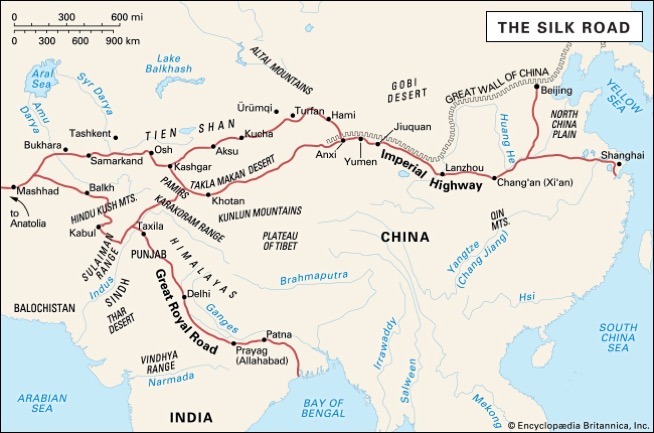
A first-ever freight train filled with Dutch-made Machinery, Mineral fuels, Pharmaceuticals, Optical, technical, medical apparatus and Organic chemicals set to depart in March 2018, for China’s heralded “New Silk Road,”. In 18 days, it is expected to arrive at the city of Yiwu in eastern China!
The New Silk Road is a trade network project spearheaded by the Chinese government’s “One Belt, One Road” initiative, announced in 2013 to promote economic corporation between China and Europe, Middle East and Central Asia. China Government with a $40 billion Silk Road Fund, aims to invest in an infrastructure network of rail links, high ways, shipping routes and also oil and gas pipelines across the Eurasian continent.
The “Silk Road” project offers the latest means to send your cargo from Europe to China to Europe via Astana, the capital city of Kazakhstan. Astana is amongst the world’s most isolated capitals, bounded by kilometers of unfilled prairie land. But there are new ways it is now making an impact, a sequence of trains, respectively hauling dozens of goods, rolling through this trade route. Most heading from China to Europe.

The Silk Road has existed for centuries, beginning during the Han dynasty (207 BCE – 220 CE). The previous overland routes were once the channels for several trades between China and Europe; they washed-out into unimportance when European ships began to circumnavigate the Cape of Good Hope. The first Silk Road was historically a vital trade route that linked China and Rome, along which goods like gold, silk, spices, tea, and wool were traded for over 2 millennia. Marco Polo voyaged to China along a similar route. The new service is part of China’s One Belt, One Road program – reviving the ancient Silk Road trading routes between China and Europe.
Since autumn 2015 NUNNER runs block trains from China to Moscow/RUS and Duisburg/DE. We offer FCL and LCL services with weekly several departures. A dedicated and cost-effective service, it takes half the time of ocean freight and is a sixth of the cost of airfreight. The “NUNNER Silkroad” delivers valuable freight from China to Western Europe economically and fast.
China direct rail cargo service to Europe is part of its drive to advance trade and investment ties with Europe. China Railway already runs services between China and other European cities, including Madrid and Hamburg. Although it takes about two weeks to cover the 12,000-mile journey, it has the benefit of being economical than air freight and quicker than sea as mentioned above. The creation of routes linking China and Amsterdam is part of a strategy aimed at boosting infrastructure links with China, Netherland, and other countries involved. The Chinese government is keen to enhance its economy in the face of reducing export and economic growth.
They are huge benefits attached to using the “Silk Road” which is running this service with China’s state-run railways. Advantages of our China Train service in a nutshell :
Establishments who deal a lot in goods which weigh a lot in contrast to their volume, that is, where airfreight turn out to be more expensive, can save a lot more with this initiative. For established cargo firms, the rail also offers the possibilities for growth.
In addition to above, there are few other salient benefits to global landscape of “One Belt, One Road” initiative
Dependent on market demand, the “Silk Road” projects look to provide the best value for money, especially where there is need to move products quicker to and from European markets with higher demands. This decision would normally be driven by customer demand for particular products. The map above showing route of the train demonstrates how market demand and the realities of globalization are increasingly realizing the revival of the ancient Silk Road.
For centuries, the famous trade route from the ancient capital of Xian provided a linkage to the busy markets of European cities. In this new era, China has become the world’s biggest exporter and the “Silk Road” make available a link to these markets. For China, it offers alternative means to sustain its economic development. And as the second biggest economy in the world right now, it gives them a great route to import high-value products from Europe.
For some nations like Kazakhstan, this is as much political as economic. It also offers China the chance to project soft power in addition to representing its influence to thread different nations from Russia to Spain together. There is also a business case for this evolving trade route to grow. Not least amid European firms looking to export to China. China is already the European Union’s second-biggest export market!
In March 2017, China’s Commerce Minister Zhong Shan said “Silk Road” project contributed 180,000 jobs and nearly $1.1 billion in tax revenue along the Belt and Road. Increasing numbers of Chinese engineers, crane operators and steel smelters stand to reap the benefits of maturing projects. Similarly, this project will create jobs in Europe and especially in Train Management and Logistics Industry.
As a conscious logistics provider, we always think of ways to reduce emission. One of the other bequests to challenge is China’s pollution issue. While rail cargo is not as eco-friendly as sea transport it releases a lesser amount of carbon dioxide (CO2) than air. Air transportation accounts for about 7% of total greenhouse gas releases, but it is troubled with difficulty to equate emissions from dissimilar transport modes as energy efficiency, load factor, and power sources all make a variation and can be hard to establish.
Like most things in business, this initiates have its fair share of challenges and issues. The few we need to be mindful of:
The “Silk Road” project, which takes in more than sixty states and quite a few international bodies, simply point toward unparalleled prospects and challenges too. Countries outside EU have their own trade compliance rules, regulations and duties.
Like every Belt and Road partner, wants its own industries to succeed, which could be a challenge for China and its partner. Sceptism and distrust have persisted during Beijing’s New “Silk Road” push. For example, Australia rejected China’s invitation to connect with the globalization strategy during Premier Li Keqiang’s visit.
There are plenty of supply chain risk we need to consider while doing business. China government is aware of this issue. Zhu Feng, who is dean of Institute of International Affairs at Nanjing University says, “Security is the most important challenge facing Belt and Road,”.
In this respect security should not be understood as the risk of theft or damage, as this type of security is not at stake. It is much more that every nation along the “Silk Road” faces an exclusive combination of challenges and risks. Many face macroeconomic challenges, due to exchange-rate unpredictability, big debt burdens, and non-diversified, unmaintainable economic assemblies. Then there are the compound and diverse laws, regulations, and rules influencing the business environment in each nation. Certainly, it is nearly impossible for the Chinese and European enterprises to comprehend completely each issue before entering it. The challenges may be multifaceted, but the plan for steering through them is modest if all parties walk together.
China, as the foremost organizer of the “One Belt, One Road” initiative, must take steps to make sure that every commerce act and participate reliably. The governments of all host nations will have to control and organize sub-national managements efficiently, while at work to make sure that competition is impartial and productive. Realizing the “Silk Road” initiative will not be simple. But China has all that is needed to succeed. On condition that it uses them in a system that is clean, green, and clear as crystal, China and other participating nations will gain massive rewards.
Erwin Cootjans
